Storing food in 5-gallon buckets has become a popular method of food preservation, particularly for people interested in emergency preparedness or homesteading.
However, many myths surround this practice, which may lead to food spoilage or other issues.
In this post, we’ll look at some of the most common myths about storing food in 5-gallon buckets and provide accurate information to help you make informed decisions about your food storage practices.
Myth #1: You Can Store Any Food In 5-Gallon Buckets
While it’s true that 5-gallon buckets can be used to store a wide variety of foods, not all foods are suitable for long-term storage.
Foods high in moisture or oils, such as fresh fruits and vegetables, are not recommended for storage in 5-gallon buckets.
These foods can spoil quickly and attract pests like rodents and insects. Dry foods like rice, beans, and flour are much better suited for long-term storage in 5-gallon buckets.
Myth #2: All 5-Gallon Buckets Are Food Safe
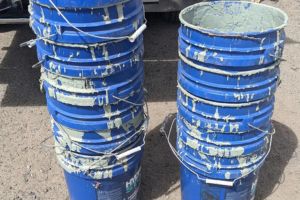 One of the most common myths about 5-gallon buckets is that all of them are food safe. While many buckets are specifically designed for food storage and labeled as such, not all are created equal. Some buckets may have been used for other purposes, such as storing chemicals or paint, and could contain harmful residues.
One of the most common myths about 5-gallon buckets is that all of them are food safe. While many buckets are specifically designed for food storage and labeled as such, not all are created equal. Some buckets may have been used for other purposes, such as storing chemicals or paint, and could contain harmful residues.
When using 5-gallon buckets for food storage, it is essential to ensure they are food safe and have not been previously used for other purposes, such as to hold chemicals or cleaning products.
Myth #3: You Don’t Need To Rotate Your Stored Food
Another common myth about storing food in 5-gallon buckets is that you don’t need to rotate your stored food.
Some people believe that once the food is stored, it will last indefinitely without further attention. However, this is not the case.
Related: How to Build Your Own Wall Hanging Can Rotator
While properly stored food can last for many years, it’s important to rotate it regularly to ensure it remains fresh and edible. This means using the oldest stored food first and replacing it with fresh food.
Myth #4: You Can Store Food In 5-Gallon Buckets Anywhere
While it’s true that 5-gallon buckets can be stored in a variety of locations, not all sites are suitable for long-term food storage, no matter what the food is stored in.
Areas subject to extreme temperatures, such as garages or sheds, can cause food to spoil more quickly. Additionally, areas prone to flooding or other natural disasters should be avoided.
When storing food in 5-gallon buckets, choosing a cool, dry location free from pests and other potential hazards is essential.
Myth #5: You Don’t Need To Use Oxygen Absorbers
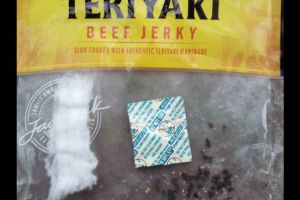 Oxygen absorbers are designed to remove oxygen from sealed containers, and they help prevent spoilage.
Oxygen absorbers are designed to remove oxygen from sealed containers, and they help prevent spoilage.
Some people think oxygen absorbers are unnecessary when storing food in 5-gallon buckets, but this is false. Oxygen is one of the main factors contributing to food spoilage.
Thus, using oxygen absorbers can help extend the shelf life of stored foods by preventing mold and bacteria growth.
Myth #6: You Can Skip Washing And Sanitizing New Buckets Before Use
Some people assume that if the buckets are new, they don’t need to be washed or sanitized before using them for food storage.
However, even new buckets can contain dust, dirt, or other debris that can contaminate your stored food.
It’s essential to thoroughly wash and sanitize your buckets before use to ensure they are clean and free from potential contaminants.
Myth #7: You Can Store Food In Any Plastic Bucket
While 5-gallon buckets are a convenient and affordable option for food storage, not all plastic buckets are created equal.
Some plastic buckets may contain chemicals or other substances that can leach into your food over time, potentially causing health issues.
When choosing buckets for food storage, look for ones made from food-grade plastic safe for extended food contact.
Myth #8: As Long As There Is A Lid, Your Food Will Be Fine
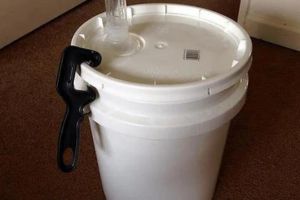 The lid is a vital aspect of any bucket storage system, as they help to keep your food fresh and free from contaminants. However, not all lids are created equal.
The lid is a vital aspect of any bucket storage system, as they help to keep your food fresh and free from contaminants. However, not all lids are created equal.
Some lids may not fit properly or make a tight seal, allowing air or moisture to enter and spoil the food.
Another thing that could ruin your food stockpile are pests. It’s best to build your own automatic traps against pests to prevent them from damaging your food supply.
Myth #9: The Label On Stored Food Is Not Important
While it may seem obvious, labeling your buckets is still essential. A clear, proper label will help avoid confusion and ensure you use the oldest food first.
Without adequate labeling, it can be challenging to remember what’s inside each bucket, leading to waste and potentially unsafe food storage practices.
Make sure to label each bucket with the contents and the date it was stored to make it easier to keep track of your food inventory.
Myth #10: You Can Store Any Amount Of Food In A Single 5-Gallon Bucket
While 5-gallon buckets can hold a significant amount of food, you must be mindful of how much you store in each bucket. Overfilling buckets can cause the lids to bulge, compromising the seal and allowing air or pests to enter the bucket.
It’s generally recommended to store no more than 25 pounds of food in a single 5-gallon bucket. You also want to ensure the lid fits correctly and your food remains fresh and safe.
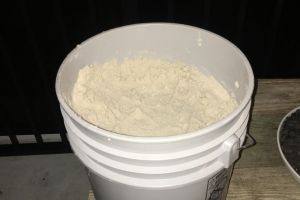 Storing food in 5-gallon buckets can be a great way to preserve food for long-term storage.
Storing food in 5-gallon buckets can be a great way to preserve food for long-term storage.
However, it’s important to dispel the myths surrounding this practice and use accurate information to ensure the food you store in 5-gallon buckets remains safe and edible.
Related: Foods You’ve Been Storing Wrong Your Whole Life
By using food-safe buckets, choosing the right foods for storage, using oxygen absorbers, rotating stored food, and choosing the right storage location, you can create a long-term food storage system that may save your life someday or will at least save you some cold, hard cash.
Other Tips And Tricks For Safe, Effective Food Storage
When storing food long-term, ingredients matter. Foods containing things like soybean or canola oil, hydrogenated oils, or hydrolyzed syrup are not meant to be kept for over a year at most, and these products must be unopened.
Ensure that you add any essential cooking directions to stored foods. Placing original prep instructions in the sealed container can help avoid confusion later.
While it may seem obvious now, you may forget the temperature or timing required to properly prep the stored items down the road.
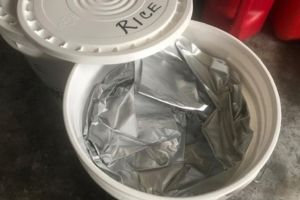 Storing food in a 5-gallon bucket is not always the most effective option. It is much safer if the food within the bucket is individually packaged and sealed so no air or pests can make contact.
Storing food in a 5-gallon bucket is not always the most effective option. It is much safer if the food within the bucket is individually packaged and sealed so no air or pests can make contact.
Packaging food in Mylar bags inside a 5-gallon container helps guarantee that it stays fresh and safe.
Avoid having your 5-gallon food storage buckets on the ground, and elevate them slightly instead. Keeping the bucket elevated even 1 inch off the floor allows it to maintain a more stable temperature and keeps the contents safe.
5-gallon buckets can be a handy tool for preparedness if used correctly. Should you choose this option, be sure you are aware of the process of protecting foods and the risks associated with long-term storage. It is also essential to remember that a 5-gallon bucket full of food will weigh a lot.
Thus, this is not always an ideal option for every person, place, or situation and should be part of your preparedness plan but not the only option. Still, having large amounts of certain products is an excellent idea in an emergency, and 5-gallon buckets may be the ideal option.
I am curious to know what types of things you store in 5-gallon buckets? I would also love to hear what you think every prepper should have stored in a 5-gallon bucket at home?
Share your thoughts and ideas in the comments so we can all be more prepared.
You may also like:
 7 DIY Projects To Have Ready When The Lights Go Out
7 DIY Projects To Have Ready When The Lights Go Out
The Great Depression Food That Saved America During Dark Times (Video)
If You Have A Generator, Do This Immediately

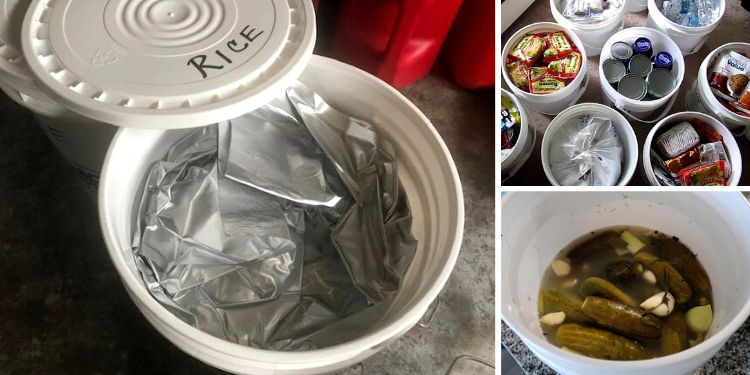













in regard to Myth #4 >> you can add the storage area “atmosphere” that is outside the bucket – preppers that have stored in a musty damp basement have experienced that taint in their stored food – same same with preppers that chose under the fuel oil tank for a storage spot >> that has the potential of actually killing you
Why? – when you have a manmade pressure/02 deprived zone centered in that bucket – Mother Nature gets pizzed and works to correct it – that bucket is drawing in the outside air thru the air permeable poly bucket – VERY slowly thru the mylar bagging – and back into the food >>>> this also why your oat meal gets pickle tainted when you use an old deli bucket – and – this is why you ALWAYS need a food grade bucket free of any post- OEM contaminates ….
and a short one – in regard to Myth #9 – I see labeling storage buckets or totes or any other prepper containers as a possible OPSEC breach – never know when someone will get a label/tag look see >>>> I color code and inventory code number my containers – color code by prep item group for a quik mad grab & run – an inventory tied to the bucket number can be much more elaborate via a computerized inventory spreadsheet ….
This is a pretty good article.
I agree with you about having a negative pressure or vacuum inside the mylar bags, and it drawing in O2 from outside, but even then, it’s tiny at best.
Mylar bags have a standard of less than 1cc of O2 exchange rate per year. It’s called the OTR or Oxygen Transfer Rate. Keep in mind there are 16.3cc per cubic INCH, so basically in 16 YEARS, you mylar bag will transfer about ONE CUBIC INCH of O2 from the outside to the inside.
You can reduce this even more by NOT creating a vacuum inside the bag, and you do this by purging the bags with nitrogen.
I have nitrogen tanks with a stainless-steel tube and hose to the tank regulator. Put the tub in the bag, open the tank and run it at about 5 to 10psi depending on the weight of the food, fill the bag with food, and I like to check it with a lit match or candle near the top of the food, and you’ll see that flame get smaller and smaller until it goes out once the bag is purged of all….well almost all the oxygen inside.
I like to take a match and just see where the O2 level is in the empty space and if the match goes out as soon as it enters the bag, its good. I throw in a couple O2 absorbers, and seal up the bag. The absorbers will collect any residual O2 inside the bag.
Now you have an O2 free environment inside the bag, WITHOUT the vacuum, and thus mother nature not trying to reach equilibrium between the inside and outside of the mylar bag.
The other thing I do, is before I do anything, I put a mylar bag inside a 5 gallon pail, and I fill the empty bag with nitrogen and set my O2 absorbers inside that mylar bag. Now I can work at my pace and not a frantic pace trying to get bags filled and sealed before the O2 absorbers start doing their thing before being put inside the bag and seal it up.
The absorbers can sit there just as if they were still in the sealed bag they were shipped in. Keep in mind that each time you reach inside that bag to get an O2 absorber, you will displace nitrogen, and O2 will take its place, so every few times reaching in the bag, it’s a good idea to just stick that tub inside the bag and give it another shot of nitrogen. Again, it’s easy to check with a match, and you’ll see the level where you go from O2 to nitrogen, because the match will go out instantly.
The other benefit of purging the bag, is if you have hard sharp items in it like rice or broken macaroni, a tight vacuum on a bag tends to want to poke tiny holes in it over time or at least stretch the bag to where the OTR can increase.
Another thing you want to do for things like macaroni, is to purge the bag, and then shake up the bag and purge it again. Do this a few times, to help get the O2 out of the little curved macaroni, and again, a lit match is the easiest way to check this.
If you use Gamma Seal lids, DO NOT directly stack buckets on top of each other. It is tempting to do so because they nest so nicely, but, unfortunately, the weight of the upper buckets will eventually cause the lids of the lower buckets to fail and punch through. (Ask me how I know!) To stack buckets, you need to place a board between the layers to distribute the weight.
Can you store 5 gallon buckets on their sides with gamma lids?
Very good article
but the most important thing about buckets , plastics, other storage units is :
They retain the imprint of what ever is stored in them ie chemicals, toxins, harmful bacterias
so : Be careful to research and always get food grade , non previous stored units
other item is moisture : they Sweat or leach moisture often used in survival for capture of water
other item : use moisture decadents specifically for food moisture evaperation
take note of the driest area s of world which have been found to have the best kept remnant s of previous civilations
Most common problem in preservation is moisture, humidity, heat , cold
once penitrated they fail the process
once bacteria grows the turn to dust
just like us , we will surely die and turn to dust
no one can exempt this
Question is what happens afterlife
judgement or reward
no hope or hopeful return as new creation
payment or forgiveness for our deeds
The Goodness of a Loving , holy, just God is what leads us to a right relationship with him
knowing he is always, and will always be there no matter what
he has given free will to all to see who will choose him and obey his commandments
no matter what , no matter who , no matter where we are or have been
he forgives , paid for our failures, sin, rebellion , opposion
he still loves us
Good refresher post on food storage tips.
Yes food grade buckets and Mylar food liners must be made in the USA. Plastics made in China may not have the same Quality standards as in the USA.
Remember we have the CCP making base fentanyl power sent to the Mexican drug cartel to weaken the American population. What is now being sent in consumer products to the USA needs better scrutiny. A decade ago we didn’t have a progressive cold war with the CCP.
good article. However, never store sugar using oxygen absorbers. You’ll end up with a solid sugar block that you won’t be able to use.
When you want to use that sugar and find that it’s a solid sugar block, break it into smaller chunks with an appropriate tool, then put a chunk in a glass jar, put a moistened layer of paper towel folded 4-thick over the top, and screw on the lid. Within a week, that chunk will fall apart in your hands.
I always always use a 5-gallon mylar bag inside 5 gallon buckets. Food never comes into contact with the bucket itself and offers an additional way to seal it away from oxygen. Everything except salt and sugar gets an O2 absorber (2000 cc) inside the bag. The mylar bags do not need to be thick or extra strong (3 mil is sufficient although thicker is okay as well) because the walls of the bucket are providing the strength. I place a wood lathe or 1×2 or board between the stacked rows of buckets so the walls of the bucket bear the weight of vertically stacked weight, and not the lids themselves (which can collapse/break under the weight of vertically stacked buckets).
For once, the title matches the well written and thought out post. Nicely done
Since I don’t like my food to come in contact with plastic (mylar is plastic), I buy organic cotton pillowcases. They are the perfect size to fit 5 gallon buckets. I put one in after washing and drying fully, hook over the bucket, put the food in, cover it with the overlapped pillowcase to ensure the food is covered completely, throw in a few oxy absorbers, and seal. You could also use a very large mylar bag, put it in first and then add the pillowcase so the mylar bag is outside the pillowcase…Food never touches plastic bucket or mylar…
Ummm, just how much weight are some people putting in 5 gallon buckets that can shear the plastic of the lower buckets? I work in the transportation industry and i’ve been around 5 gallon buckets of various fluids stacked on each other for YEARS on end, 3-4 buckets high, w/o ONE lid failure. So how tall or how heavy are some people loading their 5-gallon buckets? The buckets of various oils we use weigh about 40 pounds to a bucket at most. So in a stack of 4 the bottom bucket lid is seeing around 120 pounds of pressure at the most. Once i bought a 5 gallon bucket of lead wheel weights. Now that was incredible! Not sure of it’s exact weight, but i know it was over 120 pounds.
Richard Williams: this is for the GAMMA SEAL lids, Which are two parts and one part is in the middle. (there is an outside lip which is hammered onto the bucket to create the seal, and a twist inner circle that seals it to the outer lip.)I’m guessing the weight of the full bucket, if placed directly on top of another GAMMA SEAL lid, will cause the middle part to fall into the bucket. I can see the reasoning.
Do any of you have good information, or a very good source, on storing seeds for a long time. We have “heritage” seeds, and I know they should be kept totally dry and cool.
Any info on how to keep them dry — and other thoughts — would be welcome.
Thank you ! !
Seed saving to be viable for planting are usually good for about 1yr. After that the germination rate goes down and depends on how and where you store the seeds. There are seed saver organizations that have helpful details.
For starters; Local Seed Networks
Ahh yes, Storing toilet paper in 5 gal buckets to keep it fresh!
How about using rice as a desiccant to absorb moisture in those buckets?
Idea came from drying a wet cell phone.
Couple cups of dry white rice in a nylon knee high then tossed in the bucket should help keep things dry.
crazy squirrel: I think the problem would be that with de-moisturizing the phone, the rice is then tossed because it now contains moisture.
If rice is left in the container, it will remove the moisture to itself and then leach said moisture back into the foods if left there.
Would it be better to store in smaller food containers for those of us single people of older age also use bucket and Mylar bags to store smaller amount in each and then place them in the buckets?
Yes. We use a vacuum sealer for smaller amounts for the two of us, and also use mylar zip locks for smaller amounts, then fill buckets with those. We stack the 5 gallon buckets 5 high in a dark cool/dry location. Then we place a black heavy duty garbage bag over the stack to block light from bulb in that room. Currently ( June 2023) we are rotating out contents of bucket from 2021. Even the vac sealed brown rice is very good. We didn’t use oxygen absorbers for mylar, or special buckets…just new ones. We started our storage by using Xmas lidded popcorn tins the same way late 2020. We rotated those out earlier this year. Everything was good/fresh. We do not live in a humid or hot part of the country.
The bulb in the room is a light we only turn on when going in the storage room on occasion. The black trash bag probably isn’t necessary, but the 5 gal buckets are white. We did some with sealed lids and stacked them. None of the lids have broken. We stoped using those because they are crazy expensive and unnecessary since our small packets of vacuum seal and mylar are food safe. There is no logic in filling big buckets with beans or rice. Those doing so must have huge families.
Wondering about creating a shoulder yoke to carry 2 five gallon buckets to the stream for water. Any tips or leads?
Good idea but plastic buckets don’t last long under that type of stress. Water is heavy.
Better to use a wheel cart to carry the load. Those plastic bucket handles are not build for long term heavy weight use, they eventually fail.
Try looking for metal buckets to use with a yoke. Hopeful the metal will ne somewhat food grade. as the welded areas may have toxic solder, like lead solder.
better off using actual 5 gallon water containers like the Colemans & Aquatainers – handles are integrated into the container for the purpose ….
as far as a yoke is concerned – in the old days they’d scout for just the right shaped and thick tree branch for fabricating a man yoke – in some cultures they’d steam bend smaller branches into a yoke – with heavier woodworking tools they’d just carve out of a piece of solid wood …..
today fabricating using pipe or conduit is the best modern alternatives – foam wrap the areas of the yoke that will be making contact with the neck & shoulders ….
a yoke is a necessary alternative water carrier system to a wagon because of the possible rough ground or debris filled streets …..
After vacuum packing the mylar bag in the 5 gallon bucket I put a thin layer of Food Grade Diatomaceous Earth on top. There are many reasons why I use it, one being Bugs don’t have a chance once they come in contact with Diatomaceous Earth. It has worked for me with no problems for a long time.
Mitchell, good idea. And if you get some in your food, it’s ok as long as you use food grade and NOT the stuff meant for pools. DE will help rid the body of parasites. People often use it on themselves or their pets for that reason.
This was beyond simpleton level and I had to stop reading halfway through. No one thinks you don’t need OAs (and what you showed in the picture wasn’t an OA – it was silica). No one tries to put fresh perishable food in buckets. And if you’re using Mylar inside the buckets, you don’t need to sanitize them. The author sure likes the phrase “not all ____ are created equal (at least three times). If these articles are going to be shared, at least put a warning there for morons only. Storing fresh, perishable foods in a five gallon bucket … good grief!
Please MP, don’t you realize, not everyone has your level of knowledge so this is news to them (not me) so don’t be so condescending!
I don’t need oxygen absorbers. They are impractical because they all die very soon after opening the pack. Not usable.
We have had excellent results over two years of storage using mylar ziplocks. The food is fresh.
Agree with the rest of your points. You do not need special food safe buckets if you are using mylar. The bucket is simply a convenient place to assemble packets. No, we wouldn’t use those previously used for tar, road oil, or …..
Common sense.
WHAT DO I STORE IN 5 GALLON BUCKET? LAUNDRY SOAP AND DISHWASHER SOAP. I DIDN’T PUT IT IN THERE. THEY CAME THAT WAY FROM SMART AND FINAL.
food grade buckets :
On the bottom of the bucket, there should be a recycling symbol, which also contains a recycling number between 1 and 7. This number will be stamped between a triangle of arrows. Generally speaking, the numbers that denote food grade standards are 1, 2, 4, and 5.Apr 16, 2012
WRONG !!!! – that’s another one of the Prepper Tales that keeps circling the drain and never seems to end despite beating it down >>>>
Food Safe Plastics: Which Plastic Containers Are Safe for Storing Food and Water?
Food Grade Plastic Containers For Brining
Related to the post; Not an endorsement for ‘Patriot supply.’ Just the article.
Last week, the European Union approved a plan where the Dutch government will start buying out farmers’ businesses at between 100-120% of their appraised value as part of its goal to cut nitrogen emissions in half by 2030.
They are forcibly seizing 3,000 farms from the world’s second-largest agricultural producer (second only to the US).
But there is far more to this story… What Is Happening in Holland?
I am unable to save your site info like this one as a PDF file anymore on my PC…
Print friendly quit working on my PC for your site only so I think you did something to cause it, other sites still work and I am able to save there info as a PDF file no problem… Like to save these downloads to a flash drive so they might work after a EMP on whatever I have working still should that happen.. I am still running Windows 7 and Foxfire OS, but Print friendly does not work on you downloads… Other sites still work fine and download quickly no problem…
Thanks, I hope this helps…
Dutch
What I do is copy and paste
Windows 8 is no longer supported by Microsoftee. So new updates will not help, have to upgrade to windows 10 or Linux Ubuntu; similar o windows format.
I use mylar bags with absorbers before putting into food grade TSC buckets. I don’t use gamma lids as the mylar is already sealed.
We like the buckets because you can buy a plunger, drill holes in it – and use the bucket and plunger as a make shift mini-survival washer. At least one more good item to have for barter!
I also always place what ever is going in the 5 gallon bucket. Into my deep freezer for 3 to 5 days. That way any insects, larva, eggs, that may be in the material are frozen and killed. Then will not reproduce while in storage. Do not do this with the oxygen absorber inside they will crack open and possibly damage the food. Good Prepping!
NOT buying any food stored in POISON PLASTIC!
I cannot print anything from your site anymore. Was printing with no problems. Now shows time out and wants me to download some program. I have all types of print friendly stuff downloaded and continue to have problems with your site. I tried downloading what it wants me to download but it does not load. I don’t have problems with any other site.
Just FYI , Printers , MS printing will be controlled when failure occurs
Keep a Hardcopy paper copy in a binder of anything you need to see
When the next round of virus, shots, plandemics , kill shots come s out and marshall law and total control ,
While many will die , perish and be gone , what is left will be in koas , and controlled
Storage must be priority , because when this hits the fan , many will die
prepping for the End , after this the anti christ will appear
PLAN , PREPARE , EDUCATE , GET READY
Just FYI , Printers , MS printing will be controlled when failure occurs
Keep a Hardcopy paper copy in a binder of anything you need to see
When the next round of virus, shots, plandemics , shots come s out and marshall law and total control ,
While many will die , perish and be gone , what is left will be in koas , and controlled
Storage must be priority , because when this hits the fan , many will die
prepping for the End , after this the anti christ will appear
PLAN , PREPARE , EDUCATE , GET READY
Interesting, but some overkill. Oxygen absorbers come in a big lump package of 50-100, and have to be used very quickly once opened. Better have a lot of buckets or bags ready and have very fast sealing tools for those. We found it impractical. Mylar zip lock bags are food safe, so are vacuum seal bag materials. No reason why those … after filled ….cannot be stacked/filled into clean ordinary buckets with lids, which definitely can be stacked 4 high. Our food prepared like this has done well from over two years ago as we rotate out. Cool dry dark room for storage. A five gal bucket of beans …no matter what you use to store it is nuts for two people.
Can I safely store food in 5gal Mylar bags with oxygen absorbers in a new regular bucket if it’s in a Mylar bag? Mainly to keep it from being torn /ripped.
Just a thought on those thinking 5 gallon bucket of supply is too much:
when a neighbor comes knocking, I don’t want to turn them away. I keep some clean food safe smaller containers handy so they can be filled from the larger bucket. Not everyone has resources, space, or forethought now. I recall the pictures and stories of the Great Depression and how it impacted everybody: families were split apart, others were taking in relations and friends, children were leaving parents early, people were begging for food at kitchen doors. I think we forget how hard it is to watch others suffer. Happy prepping,, friends.